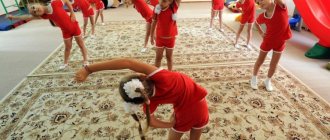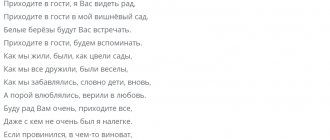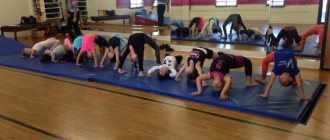Morning exercises as part of the educational process in kindergarten
All parents know the importance of doing physical exercise after waking up. But in modern life it is not always possible to maintain the correct daily routine. Admission of children to kindergarten begins at 7:00, and parents bring many children without exercise and without breakfast. Therefore, the approximate start of a weekday for preschoolers is as follows:
- 6:30–7:00 — get up, morning toilet at home;
- 7:00–8:10 — admission to the kindergarten group;
- 8:10–8:30 — morning exercises;
- 8:30–9:00 – breakfast.
What is charging for? - This is not a riddle at all - To develop strength And not get tired all day.
P. A. Sinyavsky
Morning exercises are designed to invigorate children and provide a positive emotional mood
Children should grow up healthy so that the necessary skills and abilities are easily formed and their abilities are actively developed. A healthy child is receptive to learning, understands the requirements of the teacher, and his natural interest in learning is strengthened. Therefore, exercise is a regular activity in kindergarten. The goals of morning (hygienic) gymnastics in preschool educational institutions are to preserve and strengthen the physical and mental health of preschoolers and create a positive emotional tone.
Doing exercises strengthens both physical and mental health - the child experiences positive emotions
Morning exercises are part of children’s physical activity regimen. It is a set of physical exercises for muscles and joints. Exercises for preschoolers are often supplemented with elements of breathing exercises and finger games. Morning exercises can be combined with hardening techniques. In addition to health-saving functions, exercise plays a significant role in the development of mental processes, communication abilities, and the expansion of cognitive interests. Morning exercises are one of the tools for raising a comprehensively developed personality.
In the process of performing exercises, preschoolers train attentiveness
Interesting fact. During exercise, endorphin is actively produced - the hormone of joy. It is responsible for a good mood and blocks negative emotions.
Table: tasks of morning exercises in different kindergarten groups
| Development area | First and second junior groups (1.5–4 years) | Middle group (4–5 years old) | Senior and preparatory groups (5–7 years old) |
| Physical development |
|
|
|
| Mental development |
|
|
|
| Moral development |
|
|
|
Doing morning exercises helps the body wake up
Types of morning exercises
Complexes of morning exercises are implemented according to general principles:
- accessibility: exercises and games correspond to the physical training of preschool children, explanations and demonstrations are clear;
- efficiency and benefits: exercise develops children, improves their physical condition;
- positivity: preschool children do exercises for a good mood; if the child is not inclined to physical activity (sick, upset), he is not forced to exercise.
For exercise to become a habit among children, it must captivate them and bring joy. To create sustainable motivation for preschoolers to do morning exercises, the teacher selects interesting exercises, conducts classes in a playful way, or uses unusual equipment. Let's take a closer look at what exercises are like in kindergarten.
General developmental gymnastics is a simple set of exercises, not united by any plot, aimed at stimulating motor activity. Performing movements, as a rule, takes place according to poetic texts or to musical accompaniment. Audio exercises are carried out in kindergarten from the first junior group; the melody helps children feel the pace of movements. Morning exercises can be performed with live accompaniment in the music room or using audio recordings.
Video: morning exercises “Pioneer Dawn”
“Pioneer Dawn” was familiar to all children in the USSR. Every morning, the cheerful voice of the announcer on the All-Union radio greeted the Octobrists and Pioneers. Pleasant instrumental music sounded and clear commands for movements were given. Currently, the activities of the pioneer organization are being rethought and reassessed; the movement continues to exist, preserving the time-tested methods of Soviet pedagogy. Classical exercises accompanied by upbeat music are carried out in kindergartens and schools.
Physical and play exercises can be combined by a theme in accordance with the work program. Thematic gymnastics in kindergarten is associated with the natural calendar and holidays: “Autumn”, “Winter”, “Spring”, “February 23”, “March 8”, “Cosmonautics Day”, etc. Songs, melodies, and poetic material are devoted to the general theme , attributes, role masks or caps.
Video: themed morning exercises “Winter” in the middle group
Plot exercises are a set of exercises united by a theme or built on a simple plot. Younger preschoolers love stories and poems about animals; “Bird exercises” and “Exercise about animals” are held with them. For older children, the complexes “Training of future cosmonauts”, “Atty-bats, we are soldiers”, “Sea voyage” are interesting. Exercises in story gymnastics are connected by a fictional story or an educational story: about the habits of animals and birds, about service in the army and navy, about the training of astronauts, etc.
Video: morning exercises “Journey to Murland” for children 3–4 years old
“Journey to Murland” is an excellent example of morning exercises for young children. The teacher prepared a set of exercises together with the music director: during exercises, wonderful rhythmic melodies are heard and songs are sung. The room is decorated with images of cats and plush toys. Mustaches are drawn on the faces of the children and the teacher. The children happily strive to get to a magical land, completing tasks for this purpose, and themselves “reincarnate” into kittens.
Morning exercises on beds and pajama exercises are exercises that are performed immediately after waking up. This type of charging is possible in 24-hour preschool educational institutions and five-day kindergartens, where preschoolers spend the full day, including staying overnight. Pajama gymnastics helps the whole body wake up: tissues and internal organs are actively saturated with oxygen - the muscles and brain become toned. They won’t say about a child doing gymnastics immediately after getting up: “They lifted him up, but they forgot to wake him up.”
Video: gymnastics after sleep in kindergarten
Awakening gymnastics is also carried out in the middle of the day - after a quiet hour. The same sets of exercises for the first and second half of the day are used - aimed at gently awakening the body. As shown in the video, it is correct to perform the exercises while listening to quiet, slow music. You can use audio recordings of natural sounds with instrumental accompaniment (bird songs, sounds of the forest, the sound of rain or sea).
Non-traditional exercises include gymnastic complexes using unusual equipment. These are homemade items from waste material: expanders, sensory mats and tracks, rattles, dumbbells made from plastic bottles. Under the supervision of a physical education instructor, exercises are carried out with elements of aerobics (on step platforms) and the use of sports equipment (mini-trampolines, treadmills).
Video: morning exercises on step platforms in the preparatory group
As we can see, the exercises are carried out by an instructor in the gym. The step platform seems like a simple attribute. But incorrect aerobic exercise technique can lead to excessive stress on the joints and even injuries. To carry out such exercises, consultation with a physical trainer is not enough; constant monitoring of aerobic activity is necessary.
Methodology for morning exercises in kindergarten
Morning exercises are carried out by the teacher according to pre-compiled complexes. Physical exercises and outdoor games are consistent with the physical development program: children perform familiar movements and are not taught new games during exercise. Gymnastic complexes include:
- general developmental exercises for large and small muscles;
- breathing exercises and exercises to strengthen the cardiovascular system;
- drills and games: formation, formation, turns.
For each kindergarten group, 10–12 sets of morning exercises are planned. They are repeated throughout the school year with gradual complication of the exercises, supplemented with new images, poetic texts, and music.
Morning exercises include drill exercises, for example, formation in columns
Table: stages of morning exercises
| Gymnastics stage | Content |
| Gathering for charging, building |
|
| Walking |
|
| Run |
|
| Jumping |
|
| General developmental exercises |
|
| Running at a fast pace |
|
| End of charging |
|
While performing gymnastic exercises, children work out various muscle groups.
Recommendations for charging
Morning exercises are carried out in a spacious, bright room - in a group, music or gym. The room is well ventilated before the lesson begins. The teacher and students wear comfortable clothes and shoes, preferably sportswear. Gymnastics after waking up (in 24-hour gardens) is carried out without first changing clothes - next to the beds, in pajamas or T-shirts.
Clothes for exercise should be comfortable, the same sports uniform on students looks aesthetically pleasing
In the warm season, morning exercises are recommended to be done in the fresh air - on a group site. The nature and intensity of the exercises are selected by the teacher in accordance with the temperature and clothing of the children: the colder it is outside, the more active the physical activity. In autumn, with the onset of frost and winter, exercises are carried out outside with sufficiently prepared children for the purpose of hardening.
During the warm season, the teacher and children perform morning exercises at the preschool site
The teacher does exercises together with younger preschoolers: children repeat the movements of the adult. Starting from the middle group, the teacher gives a verbal description of the exercises, draws attention to difficult movements and demonstrates the technique. Children 4–7 years old do morning exercises on their own (unless a lesson with special unfamiliar equipment/simulators is provided). One of the students is selected to demonstrate the movements. The teacher monitors all children’s exercises and corrects technical errors in movements individually. The teacher does a separate exercise with the children when he feels the need to remind them of the movements (for example, based on the name of the exercise, the children did not remember all the movements or they confuse the order of actions).
Senior preschoolers perform gymnastic exercises without the instructor demonstrating the movements
During morning exercises, the teacher uses oral counting and verbal instructions, alternates them, thereby asking ri, “right-right, left-left” (bending the body). When the instructor becomes an observer, he must continue to count (this cannot be entrusted to the child demonstrating the movements). In older groups, gestures are added to verbal instructions: moving the hand down - the children squat down, hand up - they stand in the starting position.
For different age groups, exercises are selected that are accessible to all children. They begin to complete each task simultaneously, counting with verbal instructions. The younger ones finish performing and rest, the older ones do additional approaches to count.
When one of the students demonstrates the movements, the rhythm of the exercise is set by the teacher using mental counting.
Table: examples of thematic complexes for different age groups
| Age group | Name of the complex | Content |
| First youngest | "Barbariki" |
|
| Second youngest | "Radiant sun..." |
|
| Average | "Golden Autumn" |
|
| Older | "Traffic Regulations" (Traffic Regulations) |
|
| Preparatory | "Let's fly into space" |
|
Duration of morning exercises
The total duration of the exercise (from the signal to gather to the command to disperse after gymnastics) is determined by the age of the children:
- in the first younger group - 4–5 minutes;
- in the second youngest - 5–6 minutes;
- on average - 6–8 minutes;
- in the older ones - 8–10 minutes;
- in the preparatory room - 10–12 minutes.
The pace of morning exercises is high. As little time as possible is allocated for demonstrating movements, verbal instructions, and distributing attributes. The older the students, the shorter the interval between exercises.
The distribution of equipment should take a minimum of time, so simple items for charging are selected (for example, a rope with a load)
Table: approximate time plan for morning exercises “Barbariki” in the first junior group
| Charging stage | Duration |
| Organizational moment, formation | 0.5 minutes |
| Walking | 1.5 minutes |
| General strengthening exercises | 2 minutes |
| Construction, completion of charging | 0.5–1 minute |
Table: approximate time plan for morning exercises “SDA” in the senior group
| Charging stage | Duration |
| Organizational moment, formation | 0.5 minutes |
| Walking and running | 1.5 minutes |
| Breathing exercise | 1–1.5 minutes |
| General strengthening exercises | 3–5 minutes |
| Running without a break | 0.5 minutes |
| Restoring breathing, completing charging | 1 minute |
Table: summary of the exercise “Morning exercises with the cat Leopold” (fragment)
| Author | Afanasyeva M., teacher at MBDOU D/s No. 588, Ekaterinburg, Sverdlovsk region. |
| Target | Help strengthen children's health and awaken the body for normal functioning. |
| Introductory stage | The teacher asks a riddle about a cat and says that today the cat Leopold will do exercises with them.
|
| Main part | Outdoor switchgear complex without items:
|
| Final part |
|
| Quote from: https://www.maam.ru/detskijsad/utrenja-gimnastika-s-kotom-leopoldom.html | |
On the topic: methodological developments, presentations and notes
Card file of morning exercise complexes for the entire academic year. One set of morning exercises per week.
Morning exercises are one of the important components of the motor regime; its organization should be aimed at raising the emotional and muscle tone of children.
Complex 11. Walking and running in a column, one at a time on the toes, hands on the belt; running in a column one at a time; walking and running in loose areas; Walking in a column one at a time. Exercises without objects 2. I. p.
1. ANNUAL TASKS. 2. GYMNASTICS COMPLEX.
Morning exercise complex No. 2 (with a gymnastic stick) February I Walking. Easy running. Walking on toes (arms to the sides). Walking with one step to the right, one step to the left.
Rhythmic gymnastics as a way to develop coordination of movements in older preschoolers.
So that we don’t get sick, so that we don’t catch a cold, we will do exercises every day.
Source
Text material for morning exercises in preschool educational institutions
Like any type of children's activity, exercise is accompanied by verbal creativity. Children's folklore exists in outdoor games and morning exercises in the form of short rhythmic texts. With their help, preschoolers invite their friends to exercise, encourage them to do productive work, accompany marching, greet each other and say goodbye.
Morning exercises, unfortunately, exist as an activity organized by an adult. Rhymes and mottos are passed down not from child to child, but from a teacher or parent to the younger generation. Therefore, in kindergarten, the teacher encourages children to memorize and repeat texts so that one day they can use them in doing gymnastics with their children.
Cheers for exercises can be used in the design of a sports corner in a group
Examples of chants for morning exercises in kindergarten:
- In order to grow and harden, not by the day, but by the hour, we need to do physical education.
- Accustom yourself to order, do exercises every day. Laugh, laugh more, you will be healthier.
- Everyone knows, everyone understands that it’s nice to be healthy. You just need to know how to become healthy.
- Let them fly to our room. All the snowflakes are white! We're not cold at all - We've done our exercises.
- The tough kids came out onto the playground. The tough kids did their exercises.
- Exercise is useful for everyone, Everyone needs exercise. She saves us from laziness and illness.
- Do exercises every day: fatigue, lethargy, laziness will go away.
- If someone runs away from exercise without looking back, He will not become a real strongman!
Children love sayings. Saying or shouting the motto in chorus is fun, at least. And most importantly, there is a sense of group cohesion, thanks not only to the phrase spoken by everyone together, but also to work towards a common important goal - maintaining health.
Table: examples of thematic poems for exercises (compiled based on open access materials)
| Subject | Text of poems |
| About physical education |
|
| About animals |
|
| About nature |
|
| About fairy tales |
|
On the topic: methodological developments, presentations and notes
Objectives: strengthen the muscles of the body, prevent the occurrence of flat feet, promote the formation of motor skills. Activate the body's activity. Carry out movements while waiting for the signal.
Tasks:1. Give children a boost of energy for the whole coming day, awaken them from sleep.2. Continue to teach how to perform movements synchronously, not to run in circles.
Summary of morning exercises in the senior group.
Morning exercises using ICT.
Morning exercises are a system of specially selected exercises aimed at strengthening large muscle groups and improving the health of the body.
Summary of morning exercises in the senior group with sticks. Formation Stand in one line! Match your socks. Right turn ! the one who stands behind the guide stands correctly. For the direction.
Source
Visual materials for morning exercises
In order to create positive motivation for performing gymnastics, thematic pictures, toys, and decorative elements are used. The objects most often attractive to preschoolers are used during gymnastics in younger groups - with their help, children are more easily involved in a play situation. It is important to consider that children’s attention will first concentrate on toys and bright images, so there should be few visual materials. The teacher gives the children time to look at the attributes. Kids can be told that after a productive workout they will be able to play with the figures.
The above video of the exercise “Journey to Murland” perfectly shows how to decorate the space of the gym with thematic objects - interestingly and without overloading the attention of the kids.
As the children master general strengthening exercises, the teacher turns to wall posters. It is recommended to have sets of printed diagrams with exercises for different age groups in the sports corner. You can study the posters as a reminder of the order of movements of the exercise and the technique of execution.
Gallery: morning exercise complexes in pictures
Each row of pictures represents a diagram of the exercises
The poster schematically shows the order of performing exercises with a ball and hoop.
A wall poster reminds children of the starting position, procedure and motor technique of the “Clapping” exercise.
The poster will remind the children what starting position to take and how to exercise with cubes.
The image of a funny character on the poster will attract the attention of the youngest pupils
Doing exercises by repeating the cat's movements is much more fun.
The diagram for a separate exercise can be used to explain the technique in the middle and high groups (instead of showing it to the teacher)




